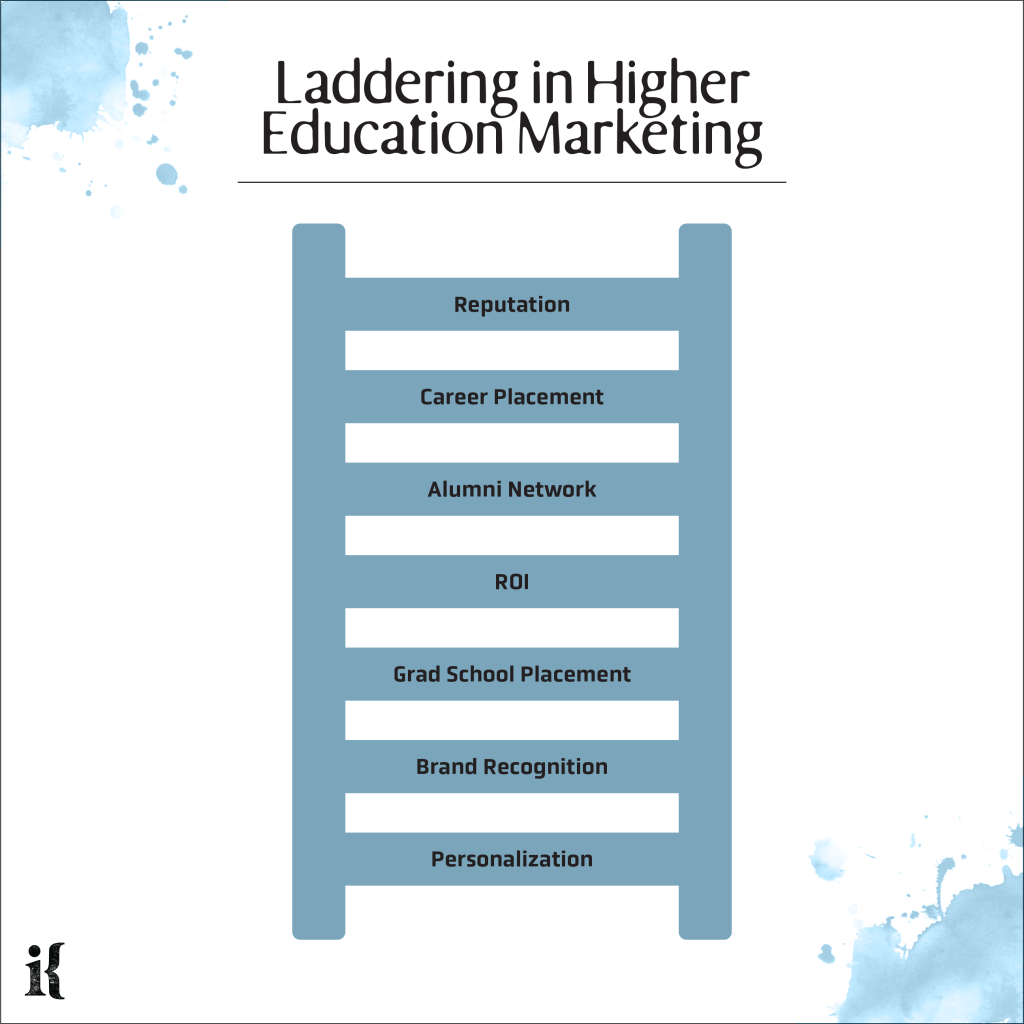Higher Education Marketing
Laddering: Higher Ed’s Tactical Opportunity

There are all sorts of communication tools to reinforce how you are different. Conceptually, though, there is a particularly powerful one that cuts to not only the core of where your brand thrives, but how that relates to a deficiency within your competitor, creating a particularly large margin in the eye of your prospective student.
Laddering is the concept of reinforcing your own brand position while de-positioning a competitor or competitive force. You do this by talking about a strength of yours that happens to be a weakness of your competitor without ever mentioning the competitive threat by name.
Consumer marketing gives us many example of these. They’re subtle, but they begin to pop out to the trained eye once you become familiar with the concept.
Consider vacation rental company VRBO whose television ads that emphasize their inventory of “only whole vacation homes” by pointing out how uncomfortable it might be to share a home with “strangers” or how “awkward” it might feel to eat a meal next to someone you don’t know.
VRBO highlights the idea that going on vacation shouldn’t be shared with those you don’t know, something most can agree on. Underneath, though, VRBO is talking about a competitor: AirBNB. AirBNB is a pioneer in the space of not only whole home rentals, but room-sharing: the “awkward” approach touted in VRBO’s ads. In essence, VRBO is de-positioning competitors like AirBNB while espousing one of its primary benefits.
AirBNB, in turn, uses laddering to take on the idea of the hotel options during group trips and family vacations. For group trips involving different friends who meet up in a city for a weekend, AirBNB points out the irony of traveling to “get together” while all staying in individual compartments (hotel rooms) which actually separates the travelers. AirBNB’s offering of taking over a whole house in that same city provides shared spaces, common areas, and more time together.
AirBNB uses a similar approach to characterize travel for parents of small children. A family of four who travels and stays overnight in a hotel room forces everyone to go to bed at the same time. AirBNB’s approach to the market on the other hand, allows the parents to stay up and enjoy some time for themselves long after the kids have gone to bed. The brand uses bedtime as a way to deposition the entire hotel industry which, unless a customer pays for a suite, doesn’t allow for a great experience for a couple who wants to stay up after the kids have gone to bed.
Similarly, Apple has also talked a great deal about consumer privacy in its ads, something that most consumers can agree with. Emphasizing privacy makes us feel safe, secure, and in control.
But during the heyday of this campaign, Apple was really talking about Facebook which had come under fire for it lack of commitment to privacy. So even though Apple was touting its commitment to privacy within its ecosystem, it was actually de-positioning Facebook’s consumer standing in one fell swoop. And for the record, Apple didn’t mention Facebook one time. It didn’t have to.
Laddering doesn’t necessarily have to involve hurting a specific competitor. It can also help to work against competitive forces, an educational alternative, or the idea of not going to college at all.
In higher education, factors like hybrid or remote learning (when other institutions only offer in-person classes, asynchronous course scheduling (when competitors offer only real-time classes), or small class sizes (when others have large classes with little to no interaction between student and professor) can all be emphasized in an effort to reinforce a market position.
To think through how this concept might work for your institution, make a list (similar to the rungs of a ladder) of brand attributes that are strengths of your institution. Once these core brand attributes are listed, consider which one represents a particular weakness of your competitive environment or competitive set. If there is a distinctive rung on your ladder that both reinforces your position while de-positioning your competitor(s), you just may have an opportunity to leverage laddering in your campaign strategy.

Like what you're reading?
Subscribe to our newsletter to get the latest insights in Higher Education and thought leadership.


